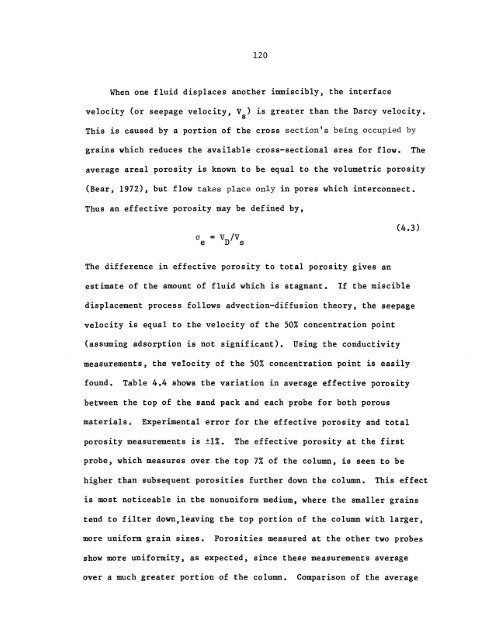longitudinal dispersion in nonuniform isotropic porous media
longitudinal dispersion in nonuniform isotropic porous media
longitudinal dispersion in nonuniform isotropic porous media
Create successful ePaper yourself
Turn your PDF publications into a flip-book with our unique Google optimized e-Paper software.
120<br />
When one fluid displaces another immiscibly, the <strong>in</strong>terface<br />
velocity (or seepage velocity, V ) is greater than the Darcy velocity.<br />
s<br />
This is caused by a portion of the cross section's be<strong>in</strong>g occupied by<br />
gra<strong>in</strong>s which reduces the available cross-sectional area for flow. The<br />
average areal porosity is known to be equal to the volumetric porosity<br />
(Bear, 1972), but flow takes place only <strong>in</strong> pores which <strong>in</strong>terconnect.<br />
Thus an effective porosity may be def<strong>in</strong>ed by,<br />
a = VD/V<br />
e s<br />
The difference <strong>in</strong> effective porosity to total porosity gives an<br />
estimate of the amount of fluid which is stagnant. If the miscible<br />
(4.3)<br />
displacement process follows advection-diffusion theory, the seepage<br />
velocity is equal to the velocity of the 50% concentration po<strong>in</strong>t<br />
(assum<strong>in</strong>g adsorption is not significant). Us<strong>in</strong>g the conductivity<br />
measurements, the velocity of the 50% concentration po<strong>in</strong>t is easily<br />
found. Table 4.4 shows the variation <strong>in</strong> average effective porosity<br />
between the top of the sand pack and each probe for both <strong>porous</strong><br />
materials. Experimental error for the effective porosity and total<br />
porosity measurements is ±l%. The effective porosity at the first<br />
probe, which measures over the top 7% of the column, is seen to be<br />
higher than subsequent porosities further down the column. This effect<br />
is most noticeable <strong>in</strong> the <strong>nonuniform</strong> medium, where the smaller gra<strong>in</strong>s<br />
tend to filter down,leav<strong>in</strong>g the top portion of the column with larger,<br />
more uniform gra<strong>in</strong> sizes. Porosities measured at the other two probes<br />
show more uniformity, as expected, s<strong>in</strong>ce these measurements average<br />
over a much greater portion of the column. Comparison of the average

















